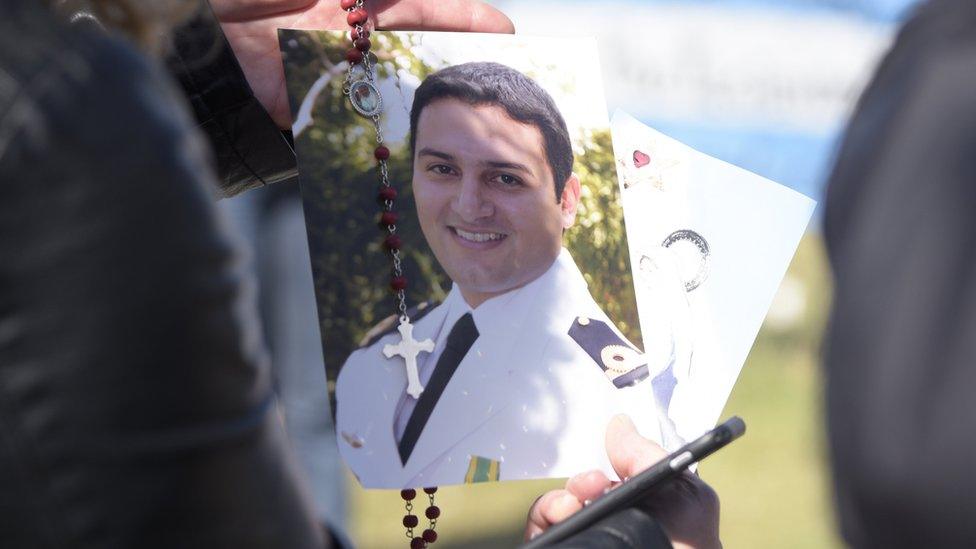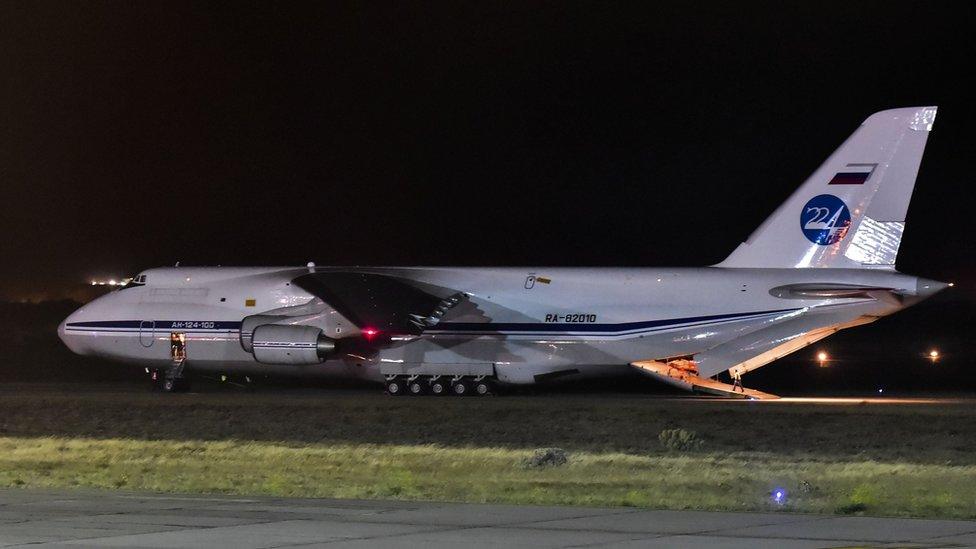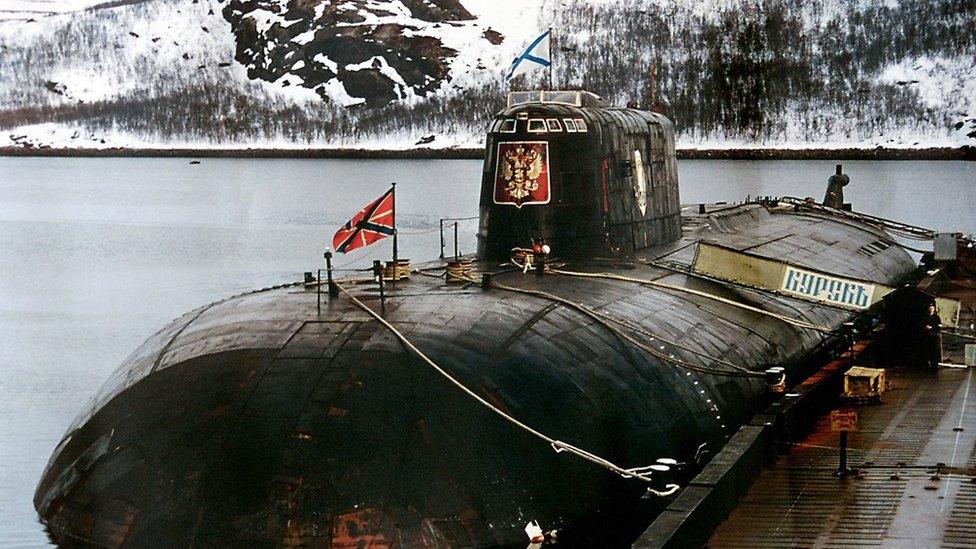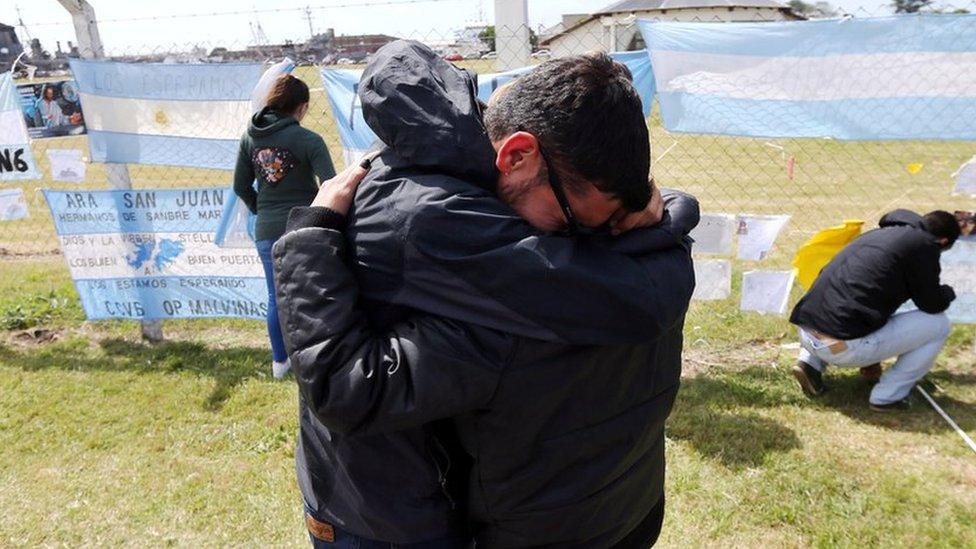Argentina missing submarine: Russia joins search
- Published

A neighbour of crew member Fernando Vicente Villarreal holds his photo at a vigil
Russia has joined the search for Argentina's missing submarine and is expected to deploy a remote-controlled device to trawl the sea on Saturday.
It is one of a dozen countries involved in the search to find out what happened to the ARA San Juan and its 44-person crew.
The sub last made contact on Wednesday 15 November.
Hopes of finding survivors have faded since a suspected explosion was reported near its last-known location.
Argentina's President Mauricio Macri said, on Friday, that an inquiry would be launched to find out the "truth" after a week of uncertainty and speculation.
Some of the relatives of the missing crew members have expressed anger at the government and the navy, saying the 34-year-old submarine was in ill repair and unsafe.
But the Argentine navy on Saturday insisted the submarine was cleared in routine checks before it set off.
Mr Macri said it had recently undergone a refit and was "in perfect condition".
What has Russia sent?
Russia's Antonov aircraft - one of the world's largest planes - landed in Comodoro Rivadavia, a city in southern Argentina, on Friday night. An expectant crowd came to watch, according to local media.
From there it headed to Ushuaia, the country's southern-most town, where the ARA San Juan began its recent trip.

Russia's Antonov plane landed in southern Argentina on Friday night
It arrived in Argentina carrying an unmanned submersible, known as the Pantera Plus, which conducts sonar scans up to a depth of 1,000 metres (3300ft).
The Russian Ministry of Defence has also sent a scientific exploration ship, Yantar, which is yet to arrive having set off from near the coast of West Africa. It will be able to search at an even deeper level.
According to AFP news agency, past tests have shown that depths plummet to more than 3,000 metres on the edge of the Argentine shelf.
Experts say the Argentine sub would begin to break-up once below depths of around 600 metres.
How Russia learnt from its own lost sub
Russia's Kursk submarine sank in the Barents Sea in 2000 after a torpedo exploded during an exercise.
All 118 on board the nuclear combat sub died, including 23 who survived the blast but died due to a lack of oxygen.
One of the last to die left a note, which signed off saying: "None of us can escape, I am writing blindly."

The Kursk submarine
The Russian government was criticised for waiting five days to accept international assistance.
The tragedy sparked the creation of the International Submarine Escape and Rescue Liaison Office (Ismerlo) three years later.
This office - based in Northwood in the UK - is behind the coordination of the global rescue effort for ARA San Juan, which was launched on 17 November when the Argentine Navy made the disappearance public.
It enabled US ships, plus planes and vessels from various other countries, to be quickly deployed.
The differences between the subs
The Kursk was a nuclear combat submarine, 154m (505ft) long and participating in military exercises.
The 66m ARA San Juan is almost exclusively dedicated to patrolling activities around the Argentine coast.
It was thought to have torpedoes on board, but a navy spokesperson denied this on Saturday.
"The explosion did not come from its own weapon or due to an external attack," confirmed Capt Enrique Baldi.

The crew of the ARA San Juan comprises 43 men and one woman
Which other countries are involved?
The US, the UK, Brazil, Chile, Norway, Germany, Canada, France, Peru, Colombia and Uruguay have also joined the search.
The US Navy has also deployed two underwater vehicles that conduct sonar scans.
A Nasa research aircraft has flown over the search area but failed to spot anything.
Families of the crew say relatives aren't being told anything
"We have the best naval, air and sensor resources available in the area, all focused on searching for the submarine," said Capt Baldi on Friday.
"We are still looking and no country is saying at the moment when they will stop. Logically it's time-limited but no-one is speaking about that at the moment."


- Published24 November 2017

- Published23 November 2017

- Published24 November 2017

- Published3 October 2017
